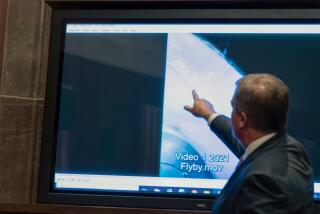Shuttle Experiments Weaken Invisible Matter Theory : Science: Astro mission found no evidence of subatomic particles believed to make up 90% of the universe. Astronomers complain about NASA’s decision to mothball the observatory.
- Share via
PHILADELPHIA — A promising theory that some scientists hoped might explain the nature of the invisible matter that makes up 90% of the universe has been all but destroyed by data collected during last month’s astronomy mission aboard the space shuttle Discovery, scientists said Thursday.
The scientists told the American Astronomical Society meeting here that the troubled Astro mission, which was plagued with problems ranging from multiple computer failures and difficulties in controlling the telescopes, was a success. But they expressed great unhappiness over the decision by the National Aeronautics and Space Administration to mothball the $150-million observatory.
Astro, which studied the universe by methods that cannot be used from the ground, was supposed to have flown several times. But NASA decided several months ago not to refly Astro because of the need to put other, higher-priority shuttle payloads on the schedule.
Thursday scientists released their first photographs from the mission, including an ultraviolet image that could not be obtained from the Earth revealing an eerie view of a gossamer cloud of gas and dust left over from the explosion of a star 20,000 years ago.
It will be months before most of the data from the eight-day mission is analyzed, but some conclusions can already be drawn. For example, according to Arthur Davidsen from Johns Hopkins University, data collected by the Hopkins Ultraviolet Telescope has invalidated one promising theory on the nature of the universe’s invisible matter.
Scientists know there is far more matter in the universe than can be seen because of the gravitational characteristics of the galaxies. A recent theory by Oxford University’s Dennis Sciama postulated that much of the invisible universe is made up of subatomic particles called tau neutrinos. The neutrino family has three members, but it is believed that only the tau could have any mass. Sciama has argued that some radioactivity in space results from the decay of the tau into another form of the neutrino.
If that could be proved, it would show that the tau has mass and thus could make up much of the invisible universe. Davidsen said his instrument was uniquely suited to find evidence of that decay but failed to detect it.
“We had the sensitivity to see it,” he said, but “we didn’t see it.”
This finding is representative of the significance of the mission, scientists said. Thrilled with the results they received, many of those working on the Astro mission have said repeatedly that they believe it is senseless to build such a costly instrument and fly it only once. The Astro observatory, for instance, cost half again as much as the world’s largest ground-based observatory, the Keck Telescope, which will study the heavens for decades.
“It’s a waste to build an instrument that functions so well and know it is not likely to fly again,” said Peter Serlemitsos of NASA’s Goddard Space Flight Center and principal investigator on Astro’s X-ray telescope. He said he achieved only one-third of his objectives, but “we got some beautiful science.”
Davidsen said his team had planned to do so much more than they were able to accomplish that “I have to report that this program, for us, has not been a success.”
One member of Davidsen’s team flew aboard the shuttle and helped run the telescopes when the automated system failed during the troubled mission. But Samuel Durrance left no doubt about what he thought of his experience.
“We were in heaven,” he said.






